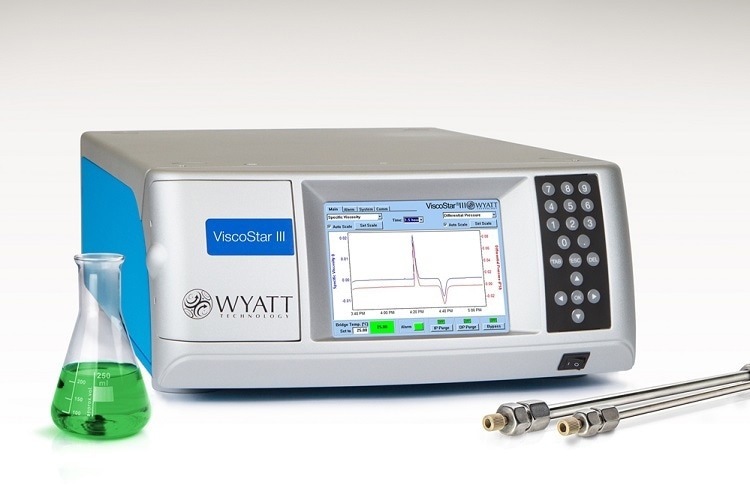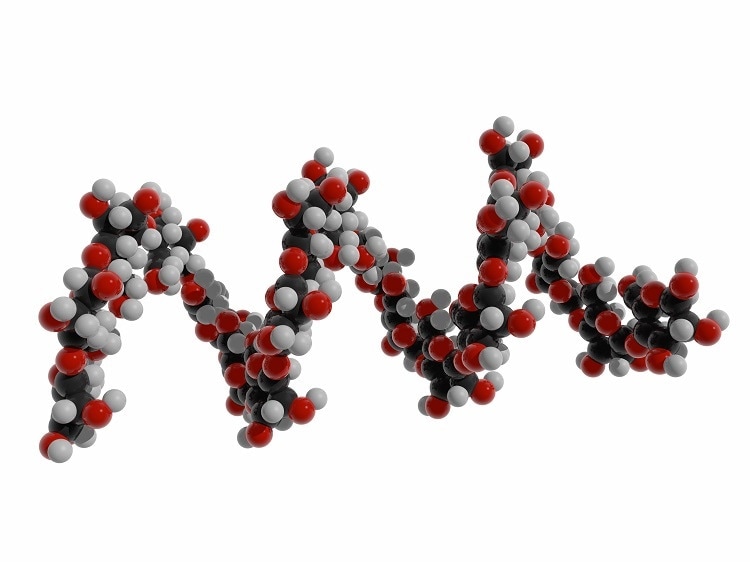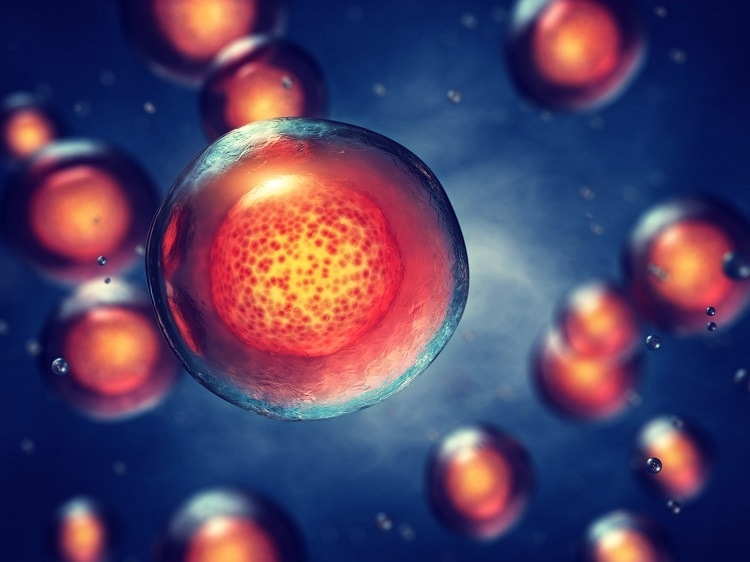 Interview conducted by Mychealla RiceJun 11 2018
Interview conducted by Mychealla RiceJun 11 2018In this interview, Steve Trainoff, Chief Scientist, from Wyatt Technology talks to AZoM about determining the size and conformation of biopolymers, synthetic polymers, proteins and peptides using the ViscoStar III.
Please tell us about the ViscoStar III.
The ViscoStar III is an online differential viscometer that is used to characterize size-exclusion chromatography (SEC) fractions of synthetic polymers and biopolymers. When coupled with a differential refractive index (dRI) detector such as the Optilab one can determine the polymer’s intrinsic viscosity, which is the ratio of the specific viscosity (measured by the viscometer) to the concentration (measured by the dRI detector).
Intrinsic viscosity essentially quantifies the volume-to-mass ratio of the polymer. Adding a multi-angle light scattering (MALS) detector further allows you to determine the molar mass and radius of gyration Rg of the sample. Combining data from all the detectors allows you to calculate the polymer’s hydrodynamic volume.
One very common application of the ViscoStar III is to analyze polymer conformation. This is done by plotting intrinsic viscosity vs. molar mass, producing a Mark-Houwink-Sakurada plot.
The slope of the resulting curve is an indicator of polymer conformation: a slope near zero indicates that the sample grows as if it were spherical, while higher slopes characterize the degree of branching or the stiffness of the polymer chains. This is critical information for understanding properties of the bulk material such as whether the sample will be strong or brittle.

The next generation online differential viscometer - The ViscoStar III from Wyatt Technology
Tell us about the benefits of the ViscoStar III?
Although differential viscometry detectors have been used for years, they have suffered from limited dynamic range and are prone to noise pickup from pump pulses. The ability to measure small peaks or the tails of big peaks is often limited by the pump stability. The 4-capillary bridge design used in modern viscometers helps cancel pump pulses, but only to a limited extent.
The ViscoStar III implements a patented new bridge design that suppresses pump pulse noise 10x more effectively than previous generations of instruments. This makes the ViscoStar III the lowest-noise viscometer available.
In addition to eliminating noise by suppressing pump pulses, the capillary bridge needs to achieve the best accuracy and widest dynamic range through a balancing procedure. The ViscoStar 3 incorporates a patented automatic bridge-balancing technique that adjusts the temperature of one arm of the bridge relative to the other three: with a press of a button the bridge is always balanced.
Others have tried complicated mechanical balancing schemes that use a motor that moves a piston with sliding seals. The ViscoStar’s thermal tuning system is elegant and robust with no moving parts.
The ViscoStar III can measure at different temperature ranges? What impact will this have?
The ViscoStar operates between 4C and 70C with an air-cooled Peltier system. Operating the instrument at high temperature helps improve solubility and reduces the solvent viscosity.
This allows one to use a higher flow rate and achieve a higher shear, which improves sensitivity. Operating around 4C is useful to improve the stability of fragile bio-molecules.

The ViscoStar III analyzes the conformation of synthetic and natural polymers. Image Credit:shutterstock.com/VichyDeal
Tell us about the primary innovations in the ViscoStar III? Do these innovations allow us to measure new samples that previously we couldn’t?
The ViscoStar III is tuned for traditional chromatography and is suitable for measuring from low molecular weight oligomers of linear polymers to highly branched, high molecular weight samples. While traditional chromatography produces peaks that are around 300µl wide, the fractionations from cutting-edge APC or UHPLC chromatography produces peaks that are more like 50-70 µl.
Such narrow peaks are challenging to measure with current capillary bridge viscometers. However, we have recently developed the microViscoStar, a variant that has extremely low internal dispersion and is suitable for the emerging world of UHPLC-SEC.
While UHPLC and APC work best for low molecular weight samples, the benefits are compelling. Run times are 4-5x faster than for standard chromatography, have improved resolution and consume far less solvent. The microViscoStar’s interdetector broadening is well below 10µl so it can easily resolve the typically narrow peaks of these systems and operate in conjunction with a µDAWN UHPLC MALS detector.

The ViscoStar III can be used for traditional chromatography and can measure low molecular weight of linear polymers. Image Credit: shutterstock.com/Miroslav Cvetinov
What makes the ViscoStar III different from any other viscometer on the market?
The ViscoStar III is the most sensitive, most stable, and lowest-dispersion differential viscometer on the market. It is over 10x more sensitive than any other online viscometer. Combined with the patented hardware improvements, it represents a huge improvement over the current state of the art.
What applications will see the benefits of the ViscoStar? How?
High-throughput applications such as process monitoring, QC and catalyst screening will benefit from the short run times. On the other hand, standard characterization runs in expensive solvents such as HFIP will see greatly reduced costs.
In addition to the traditional use in characterizing polymers, there has been a strong push towards more bio-applications. Viscometry really shines when characterizing small changes in protein conformation as measured by changes in the hydrodynamic radius. It can be used for looking at structural transitions of proteins or other biomolecules.

Studying structural transitions of proteins can be achieved using The ViscoStar III Image Credit: shutterstock.com/nobeastsofierce
What does the ViscoStar mean for the future of Viscometry?
Applications to the APC and UHPLC markets are particularly exciting. When first introduced, these systems had beautiful fractionating power, but were limited by a dearth of analytical detectors. Wyatt Technology then introduced the µDAWN MALS instrument and the Optilab UT-rEX dRI detector specifically to address this market.
Now we have filled in the remaining piece of the puzzle with the microViscoStar to offer a complete polymer characterization solution, analyzing molar mass, radius of gyration, intrinsic viscosity, and hydrodynamic radius. The complete suite of tools was designed from the ground up to ensure extremely low dispersion while maintaining highly sensitive and accurate results. Polymer R&D scientists will be able to obtain detailed characterization of more samples, in less time, with lower cost.
Where can our readers go to learn more?
To learn more please visit our webiste: https://www.wyatt.com/solutions/techniques/triple-detection.html
About Steve Trainoff
Dr. Trainoff is Wyatt Technology’s Chief Scientist working to develop new analytical instrument technologies. He graduated with honors from the California Institute of Technology with a B.S. in Physics and attended the University of California at Santa Barbara where he completed a Ph.D. in experimental physics.

His thesis work concerned the non-linear dynamics of pattern-forming systems. Concurrent with his graduate work, he consulted with a variety of companies, including Xerox. He is a Fellow of the American Physical Society.
Disclaimer: The views expressed here are those of the interviewee and do not necessarily represent the views of AZoM.com Limited (T/A) AZoNetwork, the owner and operator of this website. This disclaimer forms part of the Terms and Conditions of use of this website.